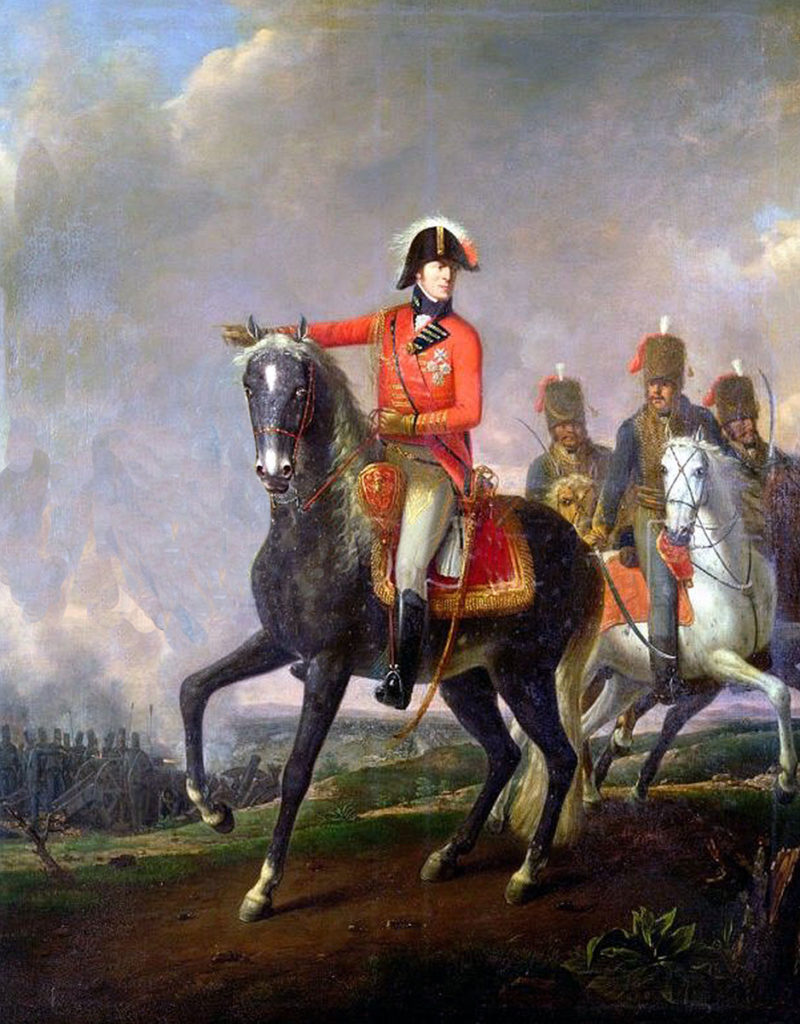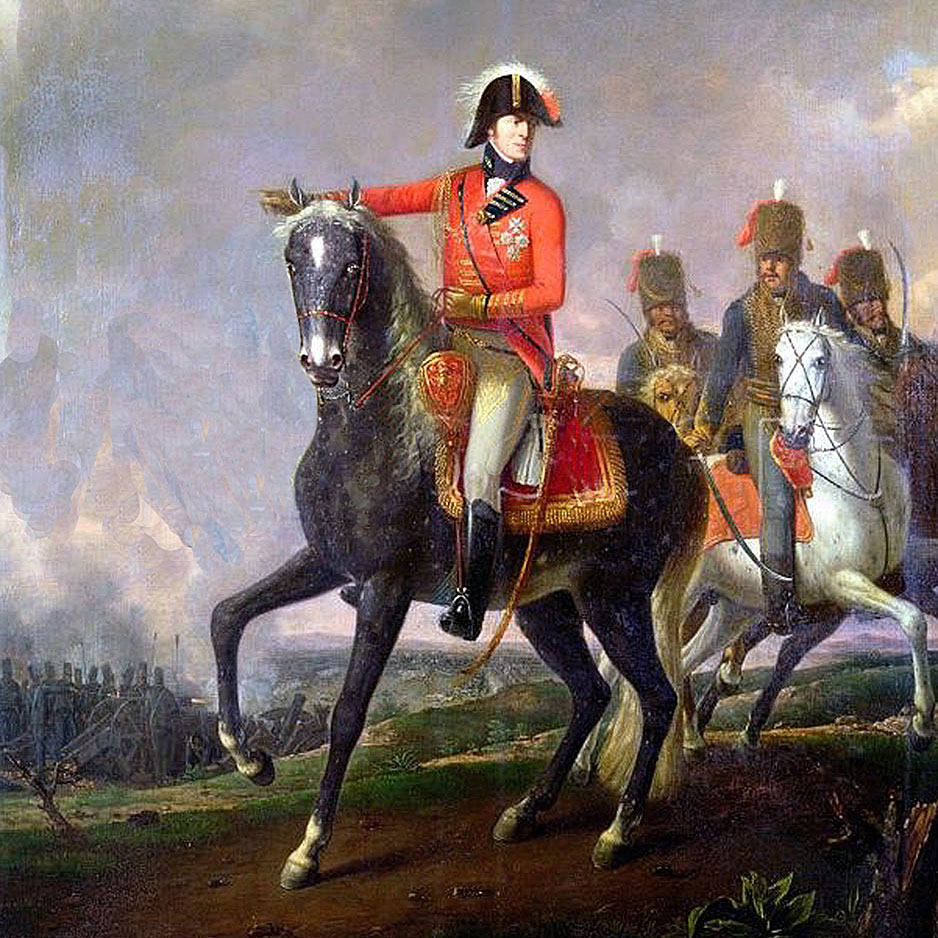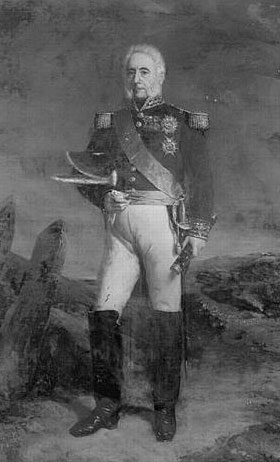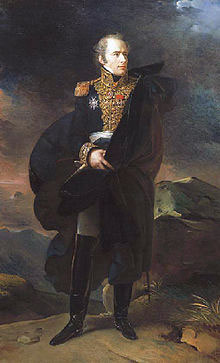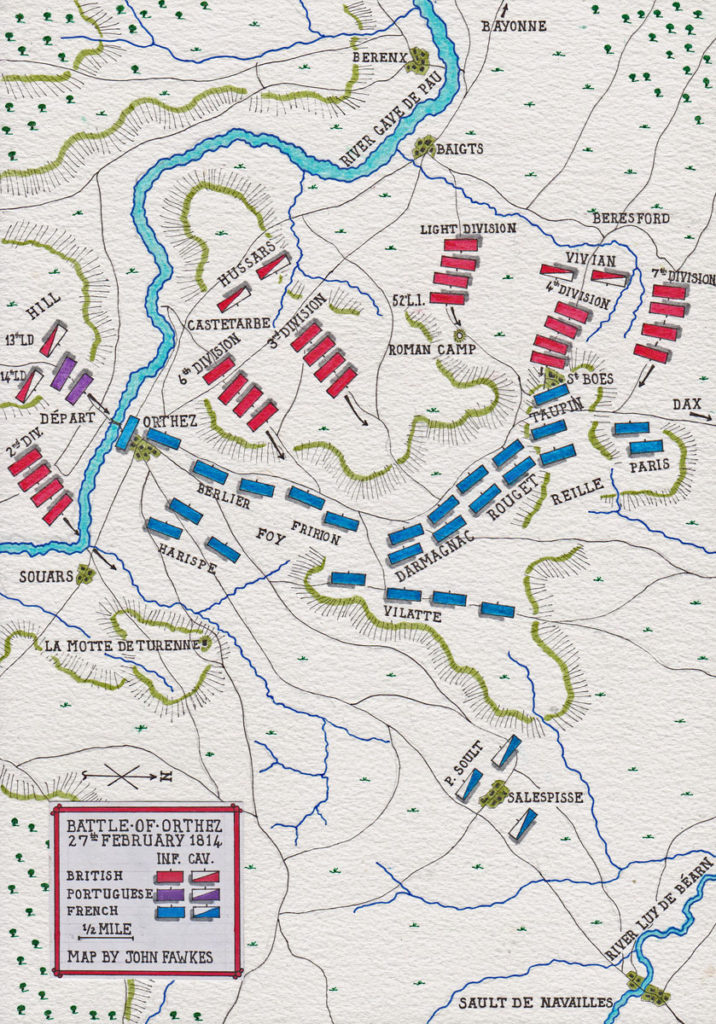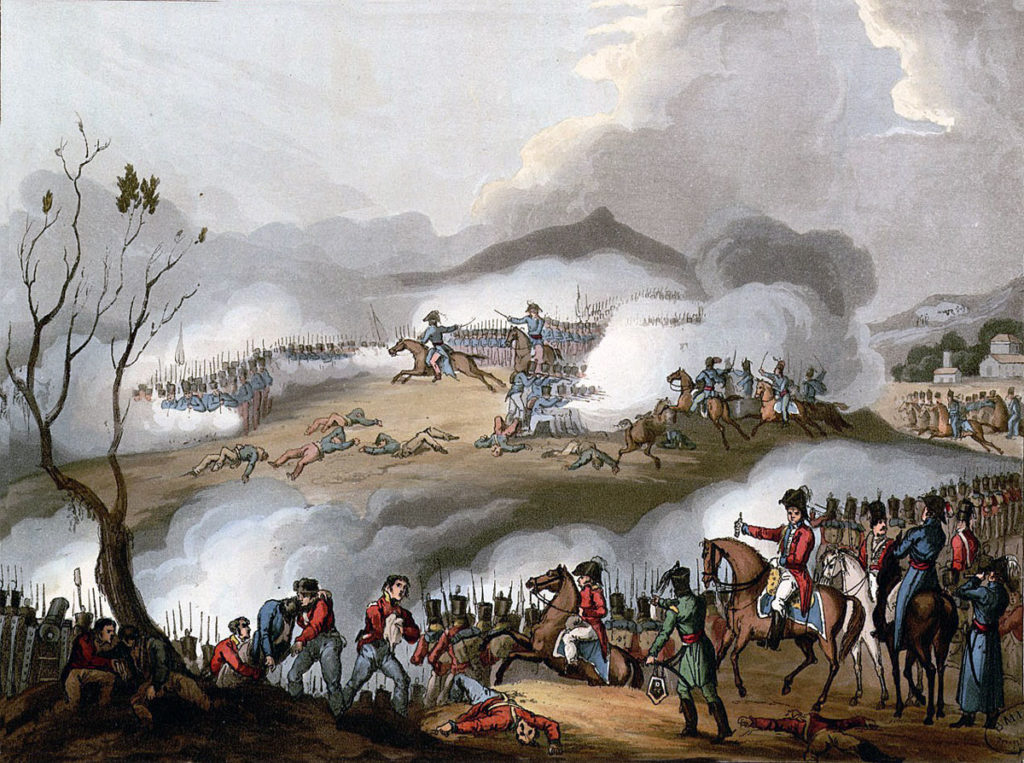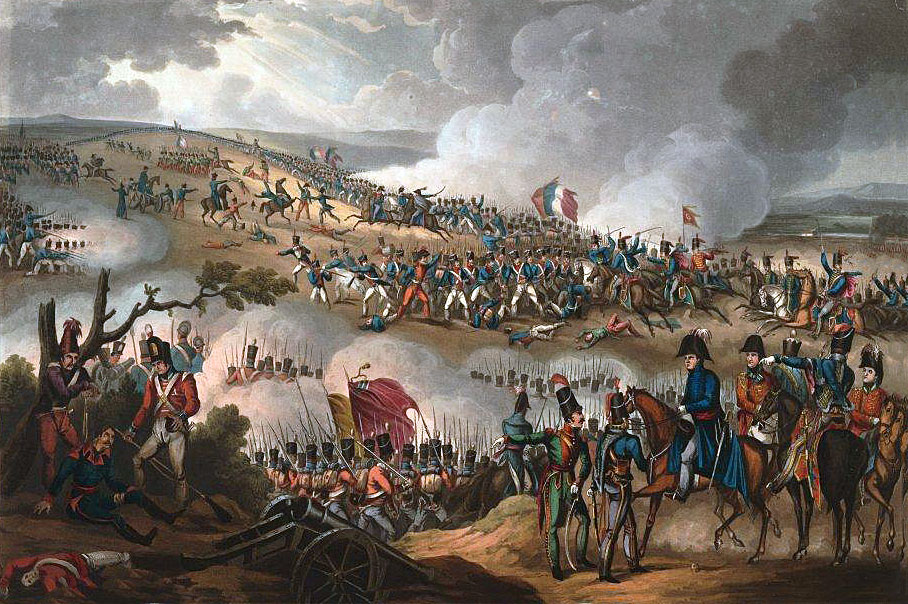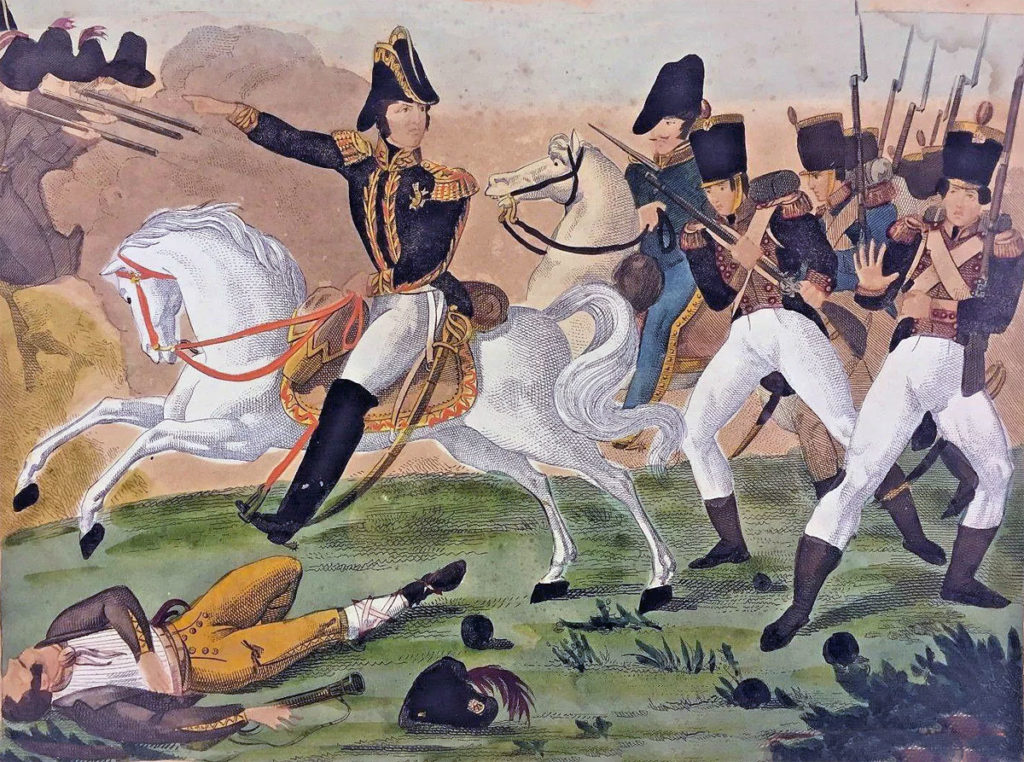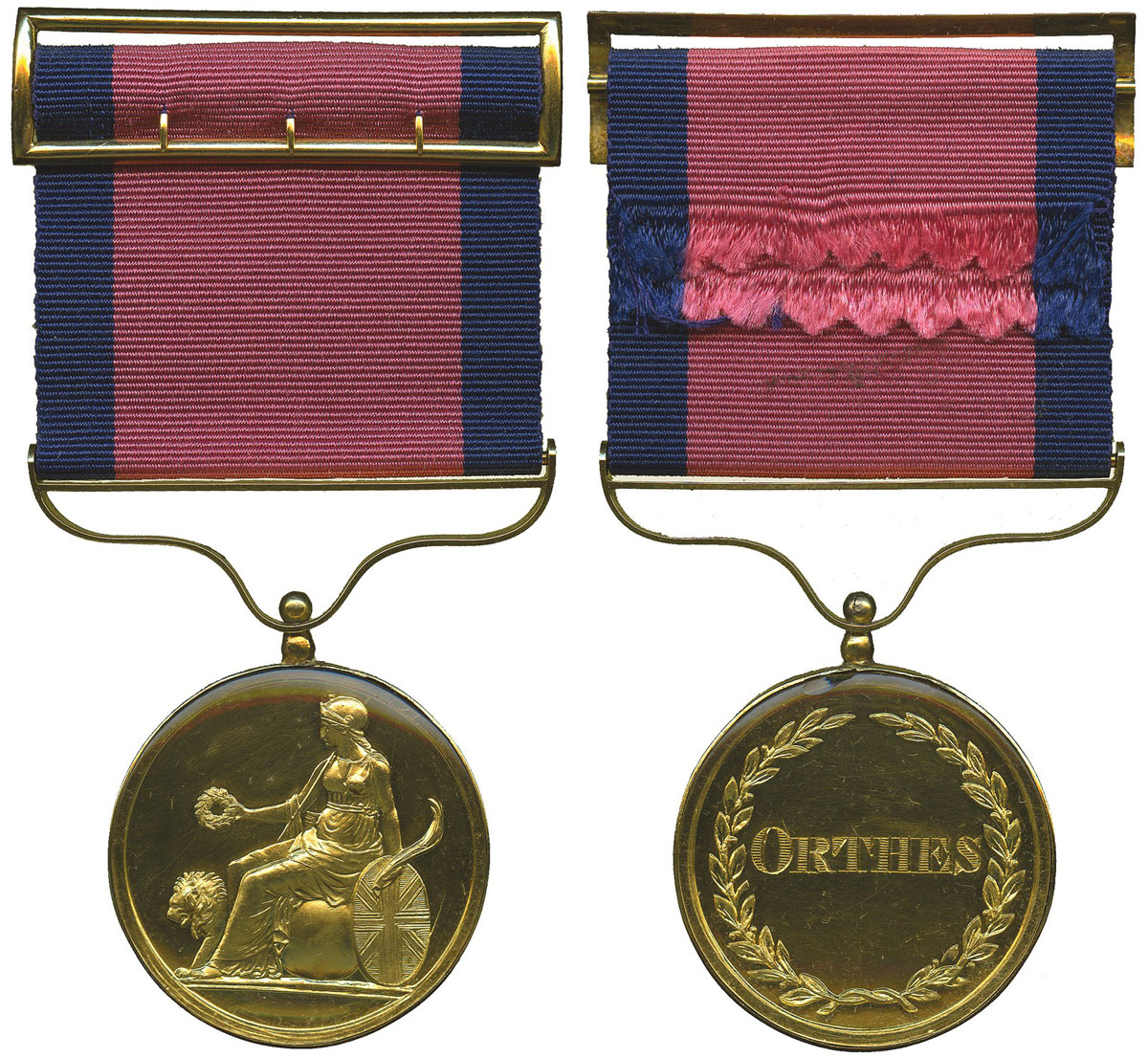The Battle fought on 2nd February 1814, during the Peninsular War, in the south-west of France, that saw Wellington push Marshal Soult’s Army of the Pyrenees back across the River Adour
48. Podcast on the Battle of Orthez fought on 2nd February 1814 during the Peninsular War in the south-west of France; with Wellington pushing Marshal Soult’s Army of the Pyrenees back across the River Adour: John Mackenzie’s britishbattles.com podcasts
The previous battle of the Peninsular War is the Battle of St Pierre
The next battle in the British Battles Sequence is the Battle of Tarbes
War: Peninsular War
Date of the Battle of Orthez: 27th February 1814
Place of the Battle of Orthez: On the north bank of the Gave de Pau River, east of Bayonne, in the south-west corner of France near the Spanish border.
Combatants at the Battle of Orthez: British, German, and Portuguese troops against the French.
Commanders at the Battle of Orthez: The Marquess of Wellington (later the Duke of Wellington) against Marshal Soult.
Size of the armies at the Battle of Orthez:
Wellington’s army comprised 30,000 British, German and Portuguese troops.
Soult’s army comprised 32,000 French troops
Winner of the Battle of Orthez:
The French army of Marshal Soult was defeated and driven back across the River Adour.
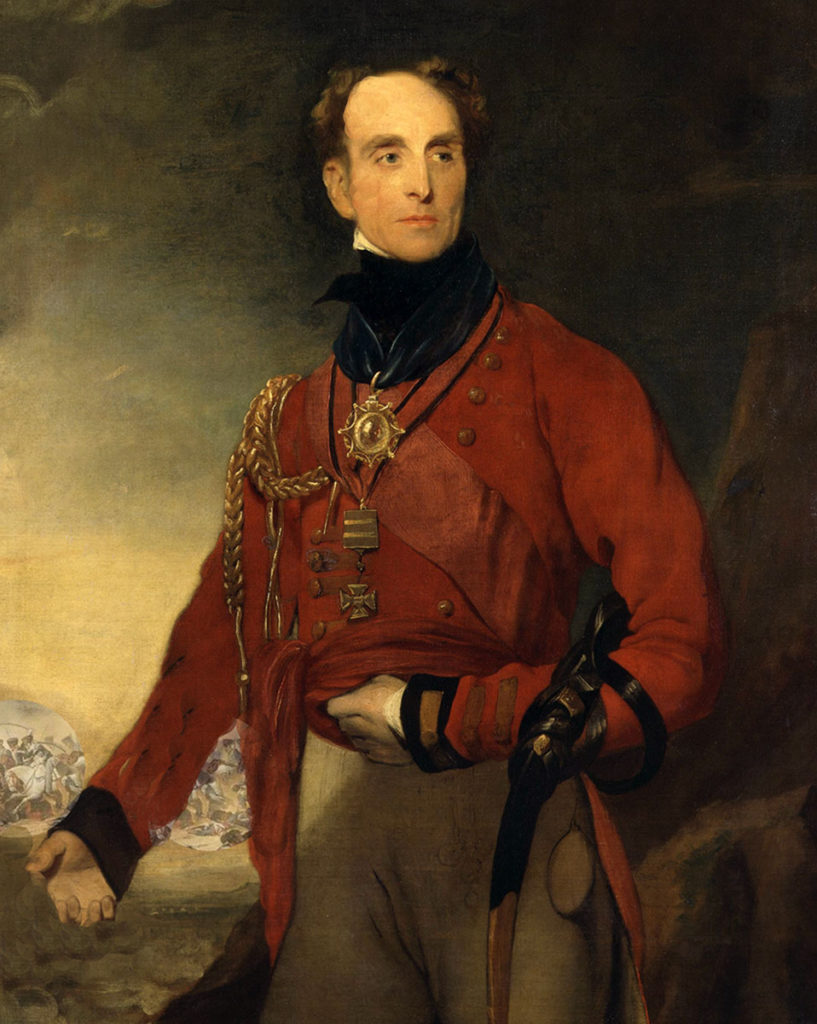
Background to the Battle of Orthez:
Marshal Soult’s French army, following the Battle of the Nive, lay with its right flank in Bayonne and its formations along the north bank of the River Adour and along its tributary, the River Gave de Pau.
The difficulties of the Emperor Napoleon in combating the armies of Austria, Russia, Prussia, Sweden and the other smaller powers in Northern Europe rebounded on Soult.
Napoleon required Soult to send picked soldiers and officers to bolster the Imperial Guard and form 20 reserve battalions.
Soult’s German and Italian regiments had either deserted or been disbanded in view of their waning reliability.
Soult’s army was reduced by some 16,000 men to 60,000.
Vilatte’s Reserve Division was broken up and a new 8th Division formed under the command of General Harispe.
Early in January 1814, following the crossing of the Rhine by the allied armies opposing the French, Napoleon called for a further dispatch of troops from the Army of the Pyrenees.
In making this demand, the Emperor relied in part on his expectation that he could sign a treaty with the Spanish Regency, bringing the war in the Peninsular to an end.
Soult was required to send north 10,000 infantry with accompanying cavalry and artillery.
There was however no sign of the Spanish leaving the war.
Soult was forced to send north Treilhard’s Dragoon Division, Sparre’s Cavalry Brigade, Leval’s and Boyer’s Infantry Divisions and 28 guns, leaving him with 48,000 men to confront Wellington’s 79,000 British, Portuguese and Spanish troops.
Losing his will to continue in an independent command in the south-west, Soult pressed for his army to be dissolved and to be recalled to the main French army in the north. No such recall was given.
The British Government was taking active steps to improve the situation of Wellington’s army, particularly in providing more secure financial support.
With this encouragement and promising news from the war against the Emperor Napoleon, Wellington resolved to force the line of the River Adour.
In the course of operations during February 1814, Soult was forced to withdraw his troops to the line of the Rivers Adour and its tributary the Gave de Pau, breaking down the bridges other than the bridge at Orthez.
The pivot for the French line remained the port city of Bayonne near the mouth of the River Adour.
On 23rd February 1814, Sir John Hope led a force across the estuary of the River Adour between Bayonne and the Bay of Biscay, with the substantial assistance of the Royal Navy squadron under Admiral Penrose.
The crossing was completed by the 27th February 1814 so that Wellington’s army almost completely surrounded Bayonne.
General Thouvenot, the governor of Bayonne, over whom Marshal Soult possessed only limited authority, being directly appointed by the Emperor, failed to intervene effectively against Hope’s crossing.
Battle of Orthez on 27th February 1814:
Soult, in the meantime, concentrated his infantry along the River Gave de Pau.
The French cavalry were positioned along the north bank of the river, with all but one regiment upstream from Orthez.
In the morning of the 25th February 1814, Hill’s Portuguese regiments advanced into the southern suburbs of Orthez, on the left bank of the River Gave de Pau and launched an unsuccessful attack on the bridge.
During the rest of the day, the balance of Hill’s corps, with the Sixth and Light Divisions, came up behind the Portuguese.
Further west, Picton’s division found the bridge at Bérenx broken and crossed the river by a ford further downstream.
Beresford came up with the Fourth and Seventh Divisions and Vivian’s cavalry brigade.
Foy withdrew from the river, enabling Beresford’s force to cross the river by a pontoon bridge and several fords.
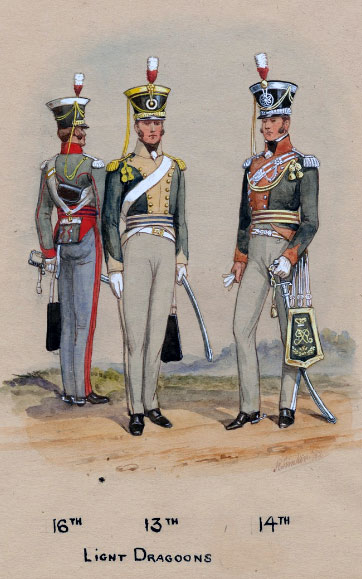
By 4pm, Beresford’s columns were approaching the town of Baigts, on the main road from Bayonne to Orthez, along the north bank of the River Gave de Pau.
The French generals gathered with Marshal Soult on the road to the west of Orthez, to devise a plan to counter the British incursion across the river.
The French general officers, including Soult, were dismayed at the threat posed by Beresford’s river crossing and proposed a retreat, other than Clausel, who was for attacking Beresford in strength.
Soult preferred retreat, but hesitated even to commit himself to this course of action. He decided to take up a position along the heights covering the road from Orthez to Dax, in the hope that Wellington would be sufficiently intimidated not to attack him.
Soult’s army formed along the heights above the Orthez-Dax road during the morning of 26th February 1814.
Taupin’s and Rouget’s divisions of infantry, with Paris’s Brigade and the 15th Chasseurs, a force commanded by Reille, occupied the French right flank on the heights behind the village of St Boes.
On the left of Reille stood Darmagnac’s infantry division.
On the left wing, Fririon’s and Berlier’s infantry brigades of Foy’s division extended the line along the road to the River Gave de Pau at Orthez.
A section of Harispe’s Division held the bridge and town of Orthez, on the north bank of the river, while the rest of Harispe’s division stood to the north of the town on the ridge cut by the road from Orthez to Sallespisse.
Villatte’s division stood in reserve, on a ridge to the north-west of the Sallespisse road.
The cavalry of Berton’s brigade and the 25th Dragoons covered the fords above Orthez, while the remaining regiments of Pierre Soult’s dragoon division held Sallespisse.
It is apparent that Marshal Soult considered the forthcoming battle to be a rear-guard action, as the artillery park and reserve artillery were already on the march for Sault de Navailles on the River Luy de Béarn in the French rear and Reille was ordered to occupy Amou to secure his crossing of the River Luy de Béarn.
Wellington did not expect Soult to give battle and interpreted his deployments as preparations for a full retreat across the Rivers Luy de Béarn and Adour.
In the early hours of 27th February 1814, Wellington’s army began to cross the River Gave de Pau.
The Sixth Division and the Light Division were over the river by 9am, joining the Hussar Brigade, Vivian’s Cavalry Brigade together with Beresford’s Third, Fourth, Sixth and Seventh Divisions of infantry.
Gathered around the suburb of Orthez, called Départ, on the south bank of the River Gave de Pau, were the Second Division, Hill’s Portuguese Divisions the 13th and 14th Light Dragoons, a troop of horse artillery and the pontoon-train.
Soult was present on the field, re-aligning Reille’s Corps on the French right, while Wellington rode down the line observing the French deployment.
The centre of the French line lay on a hill, from which the ground undulated away in each direction.
The village of St Boes, a mile from this hill, was occupied by the French 12th Light Infantry and the 15th Chasseurs à pied.
The rest of Taupin’s Division lay to their right, with Rouget’s Division and 12 guns on the central hill.
To the west of Taupin’s position was an old Roman camp on another hill. Wellington positioned himself in this camp from where he directed the initial phase of the battle.
Soult’s divisions in position around Orthez comprised 37,000 men.
Wellington deployed 33,000 men to attack the French around Orthez.
Wellington launched three attacks: the first, by the Fourth and Seventh Divisions, with a battery of artillery and supported by Vivian’s cavalry brigade, against Taupin’s Division on the French right; the second, by the Third and Sixth Divisions, supported by the Hussar Brigade, to follow the road from Baigts to Orthez and turn off to attack Darmagnac’s Division and the right wing of Foy’s Division on the road to Dax: and the third, by Hill who was to cross the river at Orthez and attack Harispe’s Division in the town.
The Light Division, lacking 2 regiments that were being re-clothed, the 43rd and 1st/95th, was posted at the Roman Camp in reserve.
Fierce fighting soon developed around St Boes, as Cole’s Fourth Division was held back by Taupin’s Division, Taupin’s guns firing straight down the village main street, keeping it clear of the attacking British infantry.
In spite of support from Barnard’s Brigade of the Light Division, the Fourth Division was forced to withdraw from St Boes.
In the second attack, the columns of the Third and Sixth Divisions advanced up the parallel roads against Damargnac and Foy.
Here also the British attack was met up by heavy artillery fire and fierce resistance from Damargnac’s and Foy’s Divisions.
At around noon on 27th February 1814, Wellington directed the second stage of his assault.
The Seventh Division, still making its way around the French right flank, was ordered to attack, while the Third and Sixth Divisions pressed home their, until now, probing advance.
To assist Cole’s Fourth Division in renewing its assault on St Boes, the 52nd Light Infantry advanced to attack Taupin’s left flank, at the join between his division and Rouget’s.
On the British right, Clinton’s Sixth Division attacked Fririon’s Brigade. Foy, the divisional commander, came forward to prevent the wavering French brigade from falling back, but was wounded by a burst of shrapnel.
Foy’s enforced withdrawal from the battle demoralised his men further and his division fell back to the north-east.
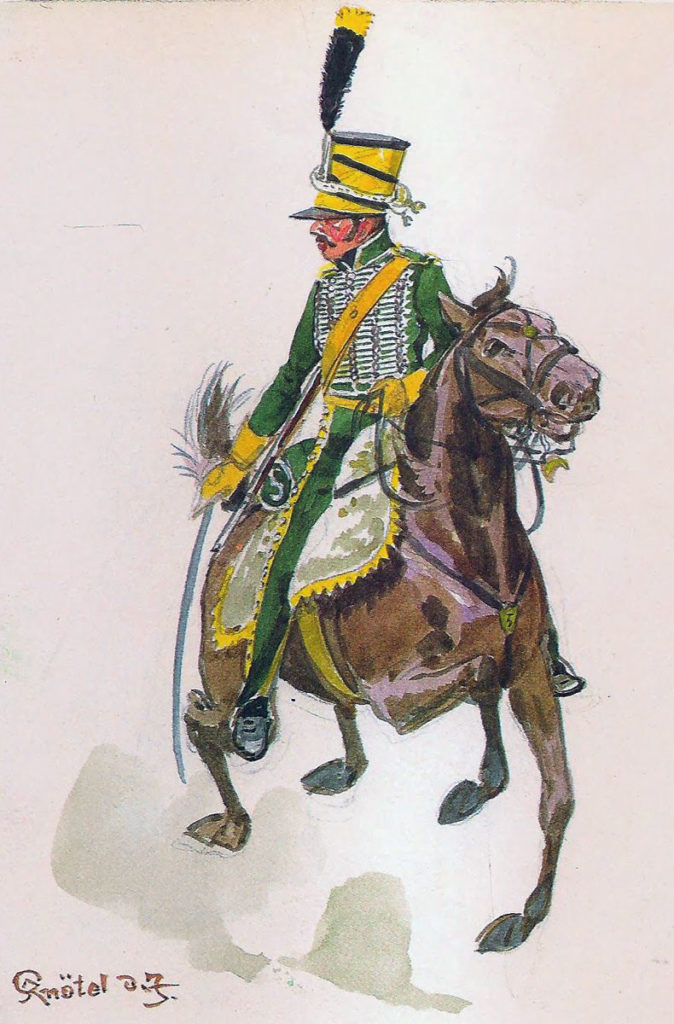
At this point Picton ordered forward his artillery. Seeing the guns approaching, Marshal Soult instructed a squadron of the 21st Chasseurs à Cheval to charge them.
During this episode there was a sharp action between the French cavalrymen and two British infantry regiments, the 88th and the 42nd, in which the Chasseurs inflicted significant casualties on the British.
The fire brought to bear on the French cavalry by the 88th finally annihilated them.
The guns advanced across the road and opened fire.
These guns and the infantry accompanying them were now subjected, for nearly two hours, to a heavy cannonade from Villatte’s Division, until that formation was forced to retreat.
On the left wing, Wellington ordered Colonel Colbourne to take his regiment, the 52nd Light Infantry, forward and deploy it in the plain towards St Boes.
As the 52nd marched up the road, they encountered General Sir Lowry Cole leading his division in retreat from St Boes, after his failure to force the village.
Colbourne urged Cole to be patient and led the 52nd forward, deploying the light infantrymen at the head of the valley, at the point of juncture between Taupin’s Division and Rouget’s right flank.
On Wellington’s left flank, the British Seventh Division came up and marched through the badly disordered Fourth Division, leaving Cole to re-form his men.
Due to various detachments, the Seventh Division comprised only 6 battalions.
General Walker, commanding the Seventh Division, sent the 6th Foot forward, while he re-formed his division and led it into the attack.
Taupin’s Division wavered under this assault and began to fall back, covered by Paris’s brigade on its right.
Beresford thereupon sent forward 2 troops of horse artillery and a battery of foot artillery, the British guns returning the medicine until then dished out by the French artillery.
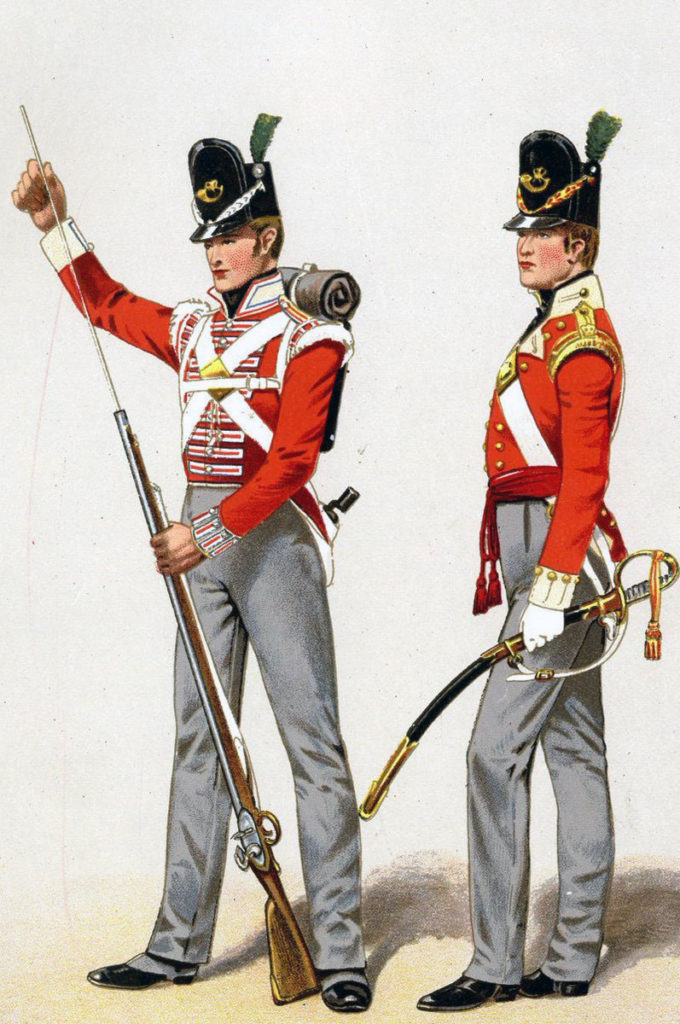
Meanwhile Colbourne led his 52nd Light Infantry through boggy ground to the top of the ridge, where they opened a heavy fire on the right flank of Rouget’s Division, while Picton’s Third Division attacked Rouget’s left flank.
In 30 minutes Rouget’s Division gave way and ran back over the ridge.
Taupin’s Division, in turn, attacked in each flank by the advancing British and Portuguese, gave way and retreated into a hollow road, where the French troops were heavily bombarded by Beresford’s guns.
Darmagnac’s Division, which had failed to provide any support to Rouget’s Division on its right or Foy’s Division on its left, now fell back some 2 miles to the road between Rontur and Dax, in line with Villatte’s Division, positioned there by Clausel.
These two divisions provided cover for the divisions of Taupin, Rouget and Foy as they retreated in disorder through Sallespisse, to the line of the River Luy de Béarn.
While these attacks were taking place in Wellington’s centre and on his left wing, Hill was crossing the River Gave de Pau straight into the town of Orthez.
Soult had ordered the destruction of the ancient stone bridge across the river, but its massive structure defied the French engineers and sufficient remained after the explosion to enable a Portuguese brigade to launch an assault across the bridge.
This assault was held back, but, while the French attention was concentrating on the Portuguese brigade, other Portuguese troops made feint advances on the nearby fords and Stewart’s Second Division crossed by a ford at Souars, a mile upstream from Orthez.
The Portuguese and the British cavalry followed Stewart across the river, the whole force advancing north to cut into the French position.
Soult moved Harispe’s Division back to positions flanking Rontun, completing a line with Villatte’s Division and Darmagnac’s Division.
Against this line Wellington launched all three attacking forces.
Picton’s Third Division suffered heavy loss before Darmagnac’s Division gave way, followed by Villatte’s and then Haraspe’s.
As Haraspe’s men fell back they were charged by the British Hussar Brigade and the 7th Queen’s Hussars cut off two battalions of French infantry, capturing many of them.
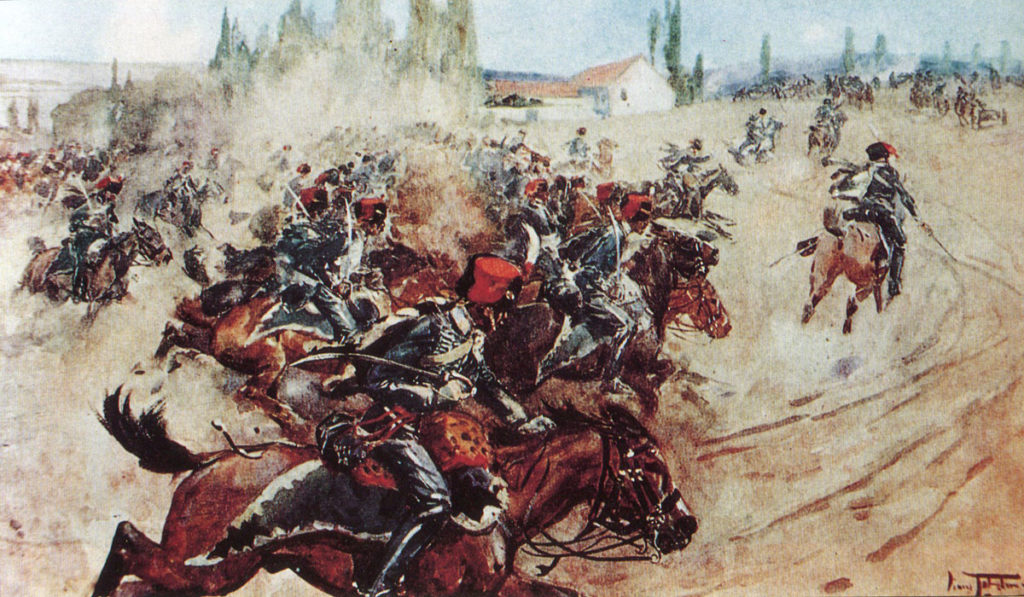
The French retreat became increasingly demoralised and only the difficulty of the country prevented heavy loss to the pursuing British cavalry.
In addition, Lord Wellington was injured by a bullet and was unable to continue in the saddle, preventing him from controlling the pursuit.
Around 6pm, the French army struggled into Sault de Navailles and crossed the River Luy de Béarn by the bridge and the neighbouring fords, under the cover of 12 cannon unlimbered on a neighbouring hill.
Darkness and the river crossing delayed the pursuing British cavalry.
At 10pm, Villatte’s infantry and Pierre Soult’s dragoons left Sault de Navailles, setting fire to the bridge.
Haraspe’s Division, coming up in the rear, was forced to put out the fire before crossing the bridge.
Taupin’s, Rouget’s, Foy’s and Damargnac’s Divisions, with Paris’s Brigade, encamped at Hagetmau, 10 miles beyond the River Luy de Béarn crossing at Sault de Navailles.
The main body was joined by Villatte’s Division at 2am on 28th February 1814, as the march north was resumed. Harispe’s Division laboured on behind the rest of the army.
Berton’s Cavalry Brigade marched from the fords above Orthez by a route well to the east of the main retreat.
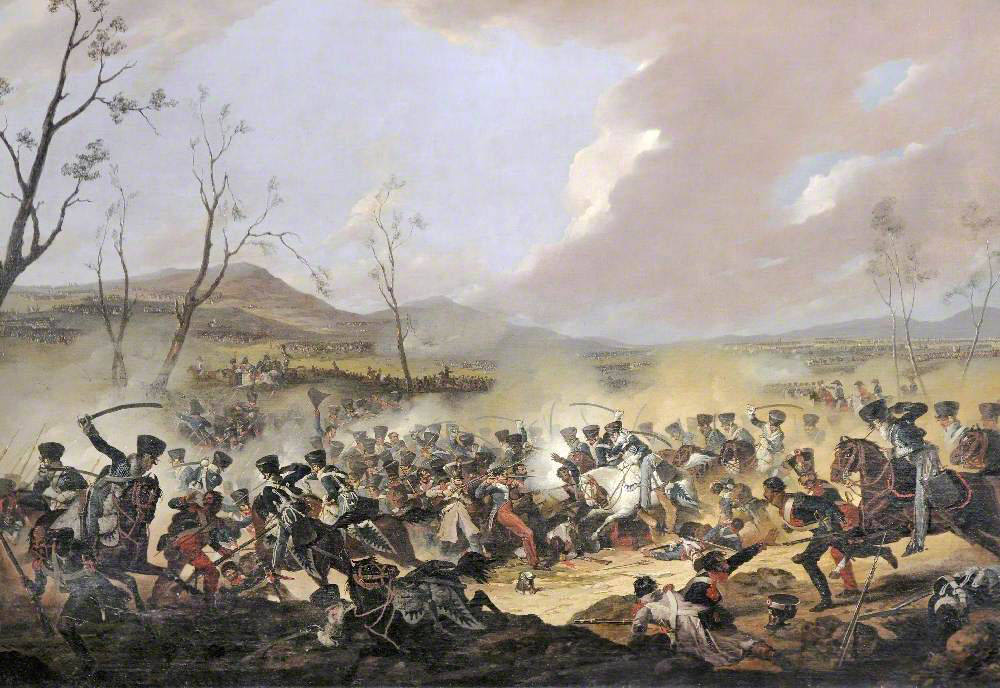
During the day, Soult’s army assembled on the right bank of the River Adour, while Wellington’s army advanced on the river at St Sever in three columns, skirmishing taking place with Pierre Soult’s dragoons.
Wellington’s intention to attack the French at St Sever was superceded by Soult’s continued retreat to Aire.
Casualties in the Battle of Orthez:
French casualties in the Battle of Orthez were 3,924 killed, wounded and missing.
The casualties by division were: Foy’s 9 battalions, 349, Darmagnac’s 11 battalions, 576, Taupin’s 10 battalions, 591, Rouget’s 7 battalions, 521, Villatte’s 8 battalions, 339, Harispe’s 11 battalions, 834, Paris’s 9 battalions, 448 and the cavalry 266.
British casualties were 1,400 and Portuguese casualties 600.
In particular among the British regiments; the 88th suffered 268 killed and wounded, the 45th suffered 130 killed and wounded, the 42nd Black Watch suffered 110 killed and wounded, the 20th Regiment suffered 120 killed and wounded, the 6th Regiment suffered 145 killed and wounded, and the 52nd Light Infantry suffered 89 killed and wounded.
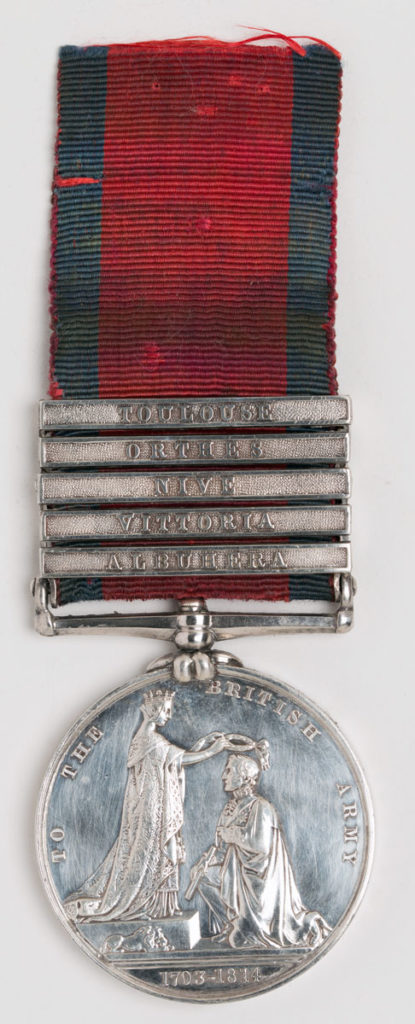
Aftermath to the Battle of Orthez:
On 2nd March 1814, Wellington renewed his attack on Soult’s army around the town of Aire.
Heavy rain interfered with movement and made the fighting difficult.
After resisting strongly, the French fell back in the evening.
By 8th March 1814, Soult was falling back on Toulouse while Wellington waited for the rains to cease before resuming his advance.
Medal and Battle Honour for the Battle of Orthez:
The Military General Service Medal 1848 was issued to all those serving in the British Army present at specified battles during the period 1793 to 1840 who were still alive in 1847 and applied for the medal. The medal was only issued to those entitled to one or more of the clasps. There were 21 clasps available for service in the Peninsular War.
The Battle of Orthez was one of the clasps.
The battle honour ‘Orthez’ was awarded to the following regiments: 7th Hussars, 13th and 14th Light Dragoons, 3rd Buffs, 5th, 6th, 7th, 11th, 20th, 23rd Royal Welch Fusiliers, 24th, 27th, 28th, 31st, 32nd, 34th, 36th, 39th, 40th, 42nd Royal Highland, 45th, 48th, 51st, 52nd Light Infantry, 58th, 60th, 68th, 71st, 74th, 82nd, 83rd, 87th, 88th, 91st, 92nd, and 95th Regiments.
The award of a battle honour seems not to have been governed by any particularly reliable benchmark. In some instances, regiments were not given a battle honour when they were present and suffered casualties.
Army Gold Medal:
In 1810 a Gold Medal was issued to be awarded to officers of rank of major and above for meritorious service at certain battles in the Peninsular War, with clasps for additional battles. The ‘Large Gold Medal’ was awarded to generals, the ‘Small Gold Medal’ to majors and colonels, with the medal replaced by a cross where four clasps were earned. The Battle of Orthez was one of the battles.
Anecdotes and traditions from the Battle of Orthez:
- The regiments involved in the combat with the squadron of the 21st Chasseurs à Cheval were from Wallace’s Brigade of the Third Division, the 88th and the 42nd. Before the French squadron was wiped out, it managed to inflict substantial casualties on the two British infantry regiments.
References for the Battle of Orthez:
See the extensive list of references given at the end of the Peninsular War Index.
The previous battle of the Peninsular War is the Battle of St Pierre
The next battle in the British Battles Sequence is the Battle of Tarbes
48. Podcast on the Battle of Orthez fought on 2nd February 1814 during the Peninsular War in the south-west of France; with Wellington pushing Marshal Soult’s Army of the Pyrenees back across the River Adour: John Mackenzie’s britishbattles.com podcasts
